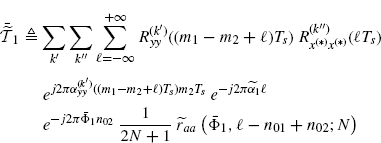3.13 Discrete-Time and Hybrid Conjugate Covariance
A complete wide-sense second-order characterization of complex processes requires the knowledge of both covariance and conjugate covariance (Picinbono 1996; Picinbono and Bondon 1997), (Schreier and Scharf 2003a,2003b).
By reasoning as in Theorems 2.6.3, 2.6.5, and 2.6.18, respectively, the following theorems can be proved.
Theorem 3.13.1 Conjugate Covariance of the Discrete-Time Cyclic Cross-Correlogram. Let xd(n) and yd(n) be zero-mean discrete-time processes defined in (2.172). Under Assumptions 2.4.2, 2.4.3, and 2.4.5 on the continuous-time processes x(t) and y(t), the conjugate covariance of the DT-CCC (2.181) is given by
(3.251) ![]()
where
(3.252) 
(3.253) 
(3.254) 
with
and
![]()
Theorem 3.13.2 Asymptotic (N→ ∞) Conjugate Covariance of the Discrete-Time Cyclic Cross-Correlogram. Let xd(n) and yd(n) be zero-mean discrete-time processes defined in (2.172). Under Assumptions 2.4.2–2.4.8 on the continuous-time processes x(t) and y(t), the asymptotic (N→ ∞) conjugate covariance of the DT-CCC (2.181) is given by
where
(3.258) 
with ![]() . In (3.257)–(3.259), for notation simplicity,
. In (3.257)–(3.259), for notation simplicity, ![]() ,
, ![]() ,
, ![]() , and
, and ![]() .
.
![]()
3.13.3 Asymptotic (N→ ∞ and Ts → 0) Conjugate Covariance of the Hybrid Cyclic Cross-Correlogram. Let y(t) and x(t) be zero-mean wide-sense jointly GACS stochastic processes with cross-correlation function (2.31c). Under Assumptions 2.4.2–2.4.8, the asymptotic (N→ ∞ and Ts → 0 with NTs→ ∞) conjugate covariance of the H-CCC (2.213) is given by
with ![]() ,
, ![]() , and
, and ![]() given by (3.138), (3.139) and (3.140) (in Theorem 3.7.2), respectively, where the order of the two limits cannot be interchanged.
given by (3.138), (3.139) and (3.140) (in Theorem 3.7.2), respectively, where the order of the two limits cannot be interchanged.
![]()






